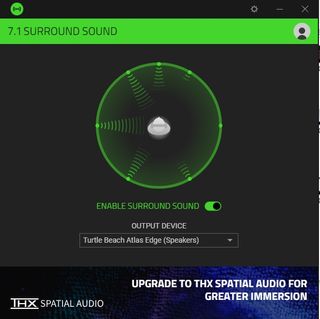Tom's Hardware Verdict
The Razer Blackshark V2 X is very light, which is great for long hours of play, and the new 50mm drivers pump solid sound. Unfortunately, the design feels fragile.
Pros
- +
Lightweight
- +
Comfortable fit
- +
Well-cushioned leatherette earpieces
- +
Decent noise cancellation
Cons
- -
No USB adapter for using software
- -
Cheap construction
Why you can trust Tom's Hardware
While the Razer BlackShark V2 headset costs $99.99, the BlackShark V2 X brings the price down to $59.99. You keep the basic hardware from the V2 while losing extra bells-and-whistles, like the USB sound card and detachable mic. This one's aimed at providing the best gaming headset with 7.1 virtual surround sound at a relatively low price, especially for Razer.
As gaming hardware becomes more ostentatious, with fancy aluminum, RGB lighting and more, it's sometimes good to have hardware that just does its job. That fits the Razer BlackShark V2 X. However, you should think twice before carelessly packing throwing these in a bag for a trip.
Razer Blackshark V2 X Specs
| Driver Type | Customized dynamic 50mm (Razer Triforce) | Row 0 - Cell 2 |
| Impedance | 32 Ohms | Row 1 - Cell 2 |
| Frequency Response | 12 Hz – 28 KHz | Row 2 - Cell 2 |
| Microphone Type | Razer HyperClear Cardioid | Row 3 - Cell 2 |
| Connectivity | 3.5mm | Row 4 - Cell 2 |
| Cords | 4.2 feet / 1.3m | Row 5 - Cell 2 |
| Weight | 0.5 pounds (240g) | Row 6 - Cell 2 |
| Lighting | None | Row 7 - Cell 2 |
| Software | Razer Synapse | Row 8 - Cell 2 |
Design



In 2012, Razer introduced the gaming community to the BlackShark. At the time, the BlackShark stood out. It was a conglomeration of black plastic and silvery metal with a neon Razer green cable. it didn't look comfortable, instead leaning heavily on utilitarian designs. In fact, Razer said it based the design on aviator headsets used by helicopter pilots. That only added to the mystique.
The Razer BlackShark V2 X is a more subtle, low-key design. It fits right in with current gaming headsets, cast in black matte plastic. There's no RGB, and even the Razer logo is in a slightly offset black. The only dash of color here is that neon green cable, which Razer does a slightly better job of hiding this time around.
The headband and inside of the earcups are covered in a soft leatherette, while the part of the earcups that rests on your face are standard fabric. The earcups themselves use a light memory foam that compresses easily, meaning they'll rest on your head nicely. I could see the fabric absorbing sweat, and during my testing, it was good enough.
I'm not a huge fan of the way Razer decided to attach the drivers to the headband. The company landed on a metal fork design with an exposed wire. The metal forks don't feel that sturdy; I gave them a bit of flex to test them, and they could probably be bent, similar to a good coat hanger. There's no swivel to them either, and I feel like this headset is going to get bent if it's packed away for travel. Likewise, the exposed wire feels like it could get caught on something and torn.
Speaking of wire, the 4.2-foot cable is wrapped in some soft plastic-like material, not the braided version that you'll find on the BlackShark V2. The included mic splitter extension cable is made from the same material, and there's no USB sound card with this model.
The left earpiece has the flexible Razer HyperClear Cardioid mic, which cannot be removed. There's also a mute button and volume control on the headset itself. I prefer volume controls on the cord itself, but that's a feature that Razer added to the pricier BlackShark V2 instead.
The stripped-down nature of the BlackShark V2 X leads to a very light headset, indeed. At 0.53 pounds, once it's on your head, you barely feel it. There's a little squeezing behind the ears because there's no swivel on the earcups. But otherwise, the BlackShack V2 X is exceedingly comfortable to wear. It's the kind of headset that you could almost forget you're wearing, if it wasn’t for the mic hanging in your peripheral vision.
Razer BlackShark V2 X Audio Performance

Razer touts its new Triforce 50mm drivers, which are designed to act like three different audio drivers in a single unit. The idea is treble, mid and bass should sound more distinct, leading to more audio clarity and a richer experience. Dropping into some K-pop, I could definitely feel the lower thumps of the bass, but there was a little muffling on the high end out of the box. I also found there was a bit of clarity lost in the spoken dialog while watching the Tenet trailer.
The BlackShack V2 X comes with a single 3.5mm plug, meaning you can use it with most modern devices outside of your gaming PC, including the PlayStation 4, Xbox One, Nintendo Switch and mobile phones. Virtual 7.1 surround sound is limited to Windows 10 (64-bit). You'll need some sort of USB connection in order to use the Razer Synapse software or 7.1 surround sound app, which doesn't come in the box. I used a Turtle Beach Atlas Edge Audio Enhancer to connect the BlackShack V2 X via USB for surround sound testing.
The 7.1 surround sound app did work. This is a separate download, activated via a code that comes with the headset. However, Razer Synapse software didn't see the BlackShack V2 X as one of its headsets. This prevented me from using the Razer Mixer to change the sound profile of the headset.
The more premium BlackShack V2 offers THX Spatial Audio for a surround sound experience. For $19.99 you can add that to the BlackShark V2 X as well (more in the Features and Software sectoin). The standard 7.1 surround sound app for our review focus just lets you turn surround sound on and off, while the full THX Spatial Audio app gives you sound calibration tools, EQ customization and per-software profiles.
The BlackShark's V2 X's surround sound app works by setting an audio output in the app itself and then setting your Windows sound to "7.1 Surround Sound." Turning on the 7.1 surround sound, I was treated to a fuller, richer sound overall. Even two-channel YouTube audio felt a bit richer, leading me to believe that Razer designed the drivers with surround sound in mind.
I was lucky to be testing Horizon Zero Dawn on PC during this review period. The soundscape of Guerilla Games' open-world adventure is fantastic and marks a great test of surround sound. In the village of Mother's Watch, I walked around and heard the chants of a singer on stage behind me as rhythmic drums boomed around me. I could also pick up snippets of conversations coming from different directions. Out in the wild, hiding in some tall grass, I was able to track a Scrapper patrolling around me purely by sound. The screech of metal as my arrows sheared off bits of armor and a droning scream as a machine went down all sounded great over the BlackShack V2 X.
Death Stranding on PC was another fantastic test of the surround sound. I wasn't sure if Hideo Kojima's delivery simulation would support 7.1 audio, but upon loading it up, I was able to hear the sounds of sorting machines within waystations, massive waterfalls and dissonant hisses from the undead BTs. Everything coming from the proper direction is a boon for immersion, and the BTs’ sequences are actually a little scarier with surround sound on.
The leatherette and memory foam earcups are designed with passive noise cancellation, covering your ears to allow for better sound isolation. In practice, that's absolutely what happened. If you need to hear sound outside of your PC, you probably shouldn't be using the BlackShack V2 X; I didn't hear someone talking directly at me while listening to Spotify. In reverse though, the sound leakage is noticeable. Those in the same room will probably hear the assorted beats, explosions and whatnot from your gaming. But if you're trying to shut out the world, this headset will do the job.
Razer BlackShark V2 X Microphone

The microphone on the BlackShack V2 X is Razer's HyperClear Cardioid. Its cardioid nature means it does its best to only pick up sound in front of the mic. It's hard to tell where that front is with the pop filter, but overall I found the mic picked up my lower voice pretty well. Recorded voice sounded slightly more nasally compared to when recording with my more expensive headsets, and a little quieter to boot. Mic quality was not as good as on my Audio-Technica AT2020 desktop mic, of course. But the BlackShark V2 X's mic stands up next to other headset mics in this price range.
The mic's active noise cancelling succeeded. Not only did the mic not pick up the evening news on my nearby television, it also didn't hear my admittedly aggressive keyboard typing or the relatively loud music coming from the headset itself. Overall, the BlackShack V2 X is a great workhorse for Zoom calls or Discord sessions.
That said, when recording a podcast, I tend to mute myself on the headset. With the BlackShack V2 X, pressing the mute button sounded like a tiny thump in my audio, regardless of how lightly I pressed the button. This was annoying, given the specific way I tend to use headsets. The volume control is less of a problem, though. Occasionally, the internal vibrations from my fiddling with the dial was captured.
Razer BlackShock V2 X Features and Software

As I noted before, the BlackShark V2 X does not come with a USB sound card like its bigger sibling does. That meant I was locked out of the features of Razer's robust Synapse software, like many will be if they are just picking up the V2 X.
The BlackShark V2 X's virtual 7.1 surround sound app is pretty barebones, allowing you to set your output sound device and turn surround sound on and off.
Most of the potential premium features require you to upgrade to THX Spatial Audio for an extra $20.
The BlackShack V2 X doesn't seem like Razer built it with software in mind. The cans could benefit from better software options, but it's also good for moving from device to device, without thinking about it too much.
Bottom Line

Razer's BlackShark V2 X is an excellent way try out successful new drivers from a reputable gaming brand, as well as virtual 7.1 surround, without spending a lot. In this case, 7.1 was noticeable and helpful for gaming. Plus, the fit is comfortable all around.
The problem is the design itself doesn't feel like it has longevity, especially when compared to Razer's own Kraken X. The latter headset has a more standardized design without the metal forks and exposed wiring on the BlackShack V2 X. It also offers 7.1 surround sound, and although Razer lists it with a $79.99 MSRP, it's been selling for $49.99 for the past few months. It's unfortunate Razer didn't roll it's new drivers into a new Kraken headset.
Not only is the BlackShack V2 X fielding competition from other Razer cans, there are other brand offers to contend with. That includes the SteelSeries Arctis 5 ($70), which has a retractable mic.
However, the BlackShark V2 X does deliver Razer's impressive Triforce 50mm drivers that play great with various types of games while blocking out distractions -- all in a well-priced package.
